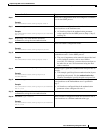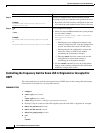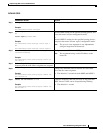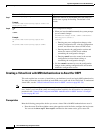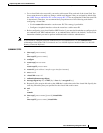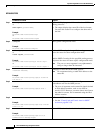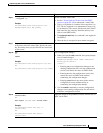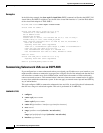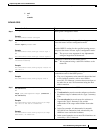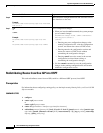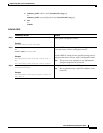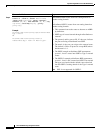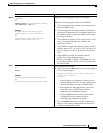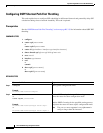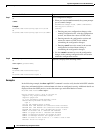
Implementing OSPF on Cisco IOS XR Software
How to Implement OSPF on Cisco IOS XR Software
RC-165
Cisco IOS XR Routing Configuration Guide
7. end
or
commit
DETAILED STEPS
Command or Action Purpose
Step 1
configure
Example:
RP/0/RP0/CPU0:router# configure
Enters global configuration mode.
Step 2
router ospf
process-name
or
router ospfv3
process-name
Example:
RP/0/RP0/CPU0:router(config)# router ospf 1
or
RP/0/RP0/CPU0:router(config)# router ospfv3 1
Enables OSPF routing for the specified routing process, and
places the router in router configuration mode.
or
Enables OSPFv3 routing for the specified routing process,
and places the router in router ospfv3 configuration mode.
Note The process-name argument is any alphanumeric
string no longer than 40 characters.
Step 3
router-id {
ipv4-address
|
interface-type
interface-instance
}
Example:
RP/0/RP0/CPU0:router(config-ospf)# router-id
192.168.4.3
Configures a router ID for the OSPF process.
Note We recommend using a stable IPv4 address as the
router ID.
Step 4
area
area-id
Example:
RP/0/RP0/CPU0:router(config-ospf)# area 0
Enters area configuration mode and configures a
nonbackbone area for the OSPF process.
• The area-id argument can be entered in dotted-decimal
or IPv4 address notation, such as area 1000 or
area 0.0.3.232. However, you must choose one form or
the other for an area. We recommend using the IPv4
address notation.
Step 5
range
ip-address mask
[advertise |
not-advertise]
or
range
ipv6-prefix
/
prefix-length
[advertise |
not-advertise]
Example:
RP/0/RP0/CPU0:router(config-ospf-ar)# range
192.168.0.0 255.255.0.0 advertise
or
Example:
RP/0/RP0/CPU0:router(config-ospf-ar)# range
4004:f000::/32 advertise
Consolidates and summarizes OSPF routes at an area
boundary.
• The advertise keyword causes the software to advertise
the address range of subnetworks in a Type 3 summary
LSA.
• The not-advertise keyword causes the software to
suppress the Type 3 summary LSA, and the
subnetworks in the range remain hidden from other
areas.
• In the first example, all subnetworks for network
192.168.0.0 are summarized and advertised by the
ABR into areas outside the backbone.
• In the second example, two or more IPv4 interfaces are
covered by a 192.x.x network.



